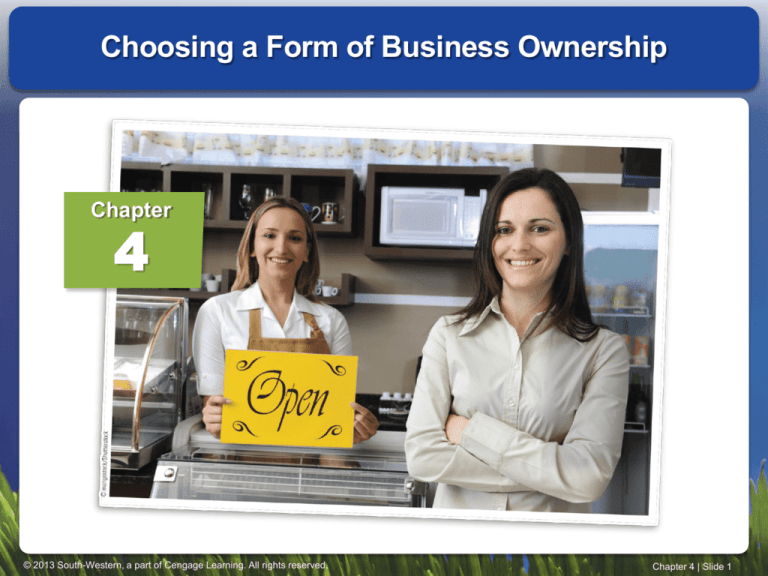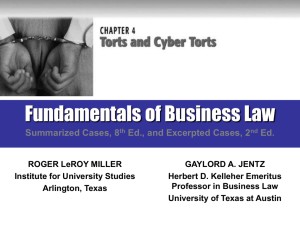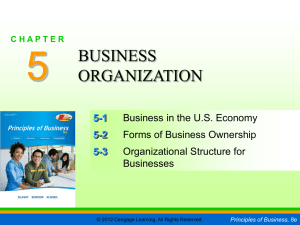
Choosing a Form of Business Ownership
Chapter
4
© 2013 South-Western, a part of Cengage Learning. All rights reserved.
Chapter 4 | Slide 1
3 Main Forms of Ownership
Sole Proprietorship
Partnership
Corporation
• S Corporation
• LLC (Limited Liability Corporation)
© 2013 South-Western, a part of Cengage Learning. All rights reserved.
Chapter 4 | Slide 2
What is liability?
To be “liable” for something means to be
responsible for it.
• In business, the owners of the business are
liable for the products (inventory), the
buildings, the employees, the income,
AND….
• The debt.
Limited liability
Unlimited liability
© 2013 South-Western, a part of Cengage Learning. All rights reserved.
Chapter 4 | Slide 3
Sole Proprietorships
A business that is owned (and usually
operated) by one person
The simplest form of business ownership and
the easiest to start
The most popular form of business ownership
© 2013 South-Western, a part of Cengage Learning. All rights reserved.
Chapter 4 | Slide 4
Relative Percentages of Sole Proprietorships,
Partnerships, and Corporations in the U.S.
Source: U.S. Bureau of the Census, Statistical Abstract of the United States, Washington, D.C., 2010, Table 729 (www.census.gov).
© 2013 South-Western, a part of Cengage Learning. All rights reserved.
Chapter 4 | Slide 5
Total Sales Receipts of American Businesses
© 2013 South-Western, a part of Cengage Learning. All rights reserved.
Chapter 4 | Slide 6
Advantages and Disadvantages
of Sole Proprietorships
ADVANTAGES
• Ease of start-up
and closure
• Pride of ownership
DISADVANTAGES
– Unlimited liability
• The business owner is
personally responsible for all
the debts of the business
• Retention of all profits
– Lack of continuity
• No special taxes
– Lack of money to put into
the business
• Flexibility of being your
own boss
– Limited management skills
– Difficulty in hiring
employees
© 2013 South-Western, a part of Cengage Learning. All rights reserved.
Chapter 4 | Slide 7
Partnerships
A voluntary association of two or more persons to act
as co-owners of a business for profit
Less common form of ownership than sole
proprietorship or corporation
No limit on the maximum number of partners; most
have only two
© 2013 South-Western, a part of Cengage Learning. All rights reserved.
Chapter 4 | Slide 8
Types of Partners
General partner
•
A person who assumes full or shared responsibility for operating a
business
• General partnership: a business co-owned by two or more general
partners who are liable for everything the business does
Limited partner
•
A person who contributes capital to a business but has no
management responsibility or liability for losses beyond the amount he
or she invested in the partnership
•
Limited partnership: a business co-owned by one or more general
partners who manage the business and limited partners who invest
money in it
© 2013 South-Western, a part of Cengage Learning. All rights reserved.
Chapter 4 | Slide 9
The Partnership Agreement
Articles of partnership
• An agreement in writing explaining the terms of the
partnership
• Agreement should state
–
–
–
–
–
Who will make final decisions
What each partner’s duties will be
How much each partner will invest
How much profit or loss each partner receives
or is responsible for
How the partnership can be dissolved
© 2013 South-Western, a part of Cengage Learning. All rights reserved.
Chapter 4 | Slide 10
Articles of Partnership
© 2013 South-Western, a part of Cengage Learning. All rights reserved.
Chapter 4 | Slide 11
Articles of Partnership (cont.)
© 2013 South-Western, a part of Cengage Learning. All rights reserved.
Chapter 4 | Slide 12
Advantages and Disadvantages
of Partnerships
ADVANTAGES
DISADVANTAGES
• Ease of start-up
• Unlimited liability
• Availability of capital
• Management
disagreements
•
•
•
•
and credit
Personal interest
Combined business skills
and knowledge
Retention of profits
No special taxes
© 2013 South-Western, a part of Cengage Learning. All rights reserved.
• Lack of continuity
• Frozen investment-easy
to invest in, but
sometimes hard to get
your money back out if
you need to.
Chapter 4 | Slide 13
Corporations
An artificial person created by law with most of the
legal rights of a real person, including the rights to
start and operate a business, to buy or sell property,
to borrow money, to sue or be sued, and to enter
into binding contracts.
Unlike a real person, however, a corporation exists
only on paper.
They comprise about 19% of all businesses, but they
account for 83% of sales revenues.
© 2013 South-Western, a part of Cengage Learning. All rights reserved.
Chapter 4 | Slide 14
Stock Ownership in a Corporation
Important Terms:
• Stock
–
The shares of ownership of a corporation
• Stockholder
–
A person who owns a corporation’s stock
• Closed corporation
–
A corporation whose stock is owned by relatively few
people and is not sold to the general public
• Open corporation (publicly traded)
–
A corporation whose stock is bought and sold on the
stock exchange and can be purchased by any
individual
© 2013 South-Western, a part of Cengage Learning. All rights reserved.
Chapter 4 | Slide 15
Forming a Corporation
Incorporation
• The process of forming a corporation
Most experts recommend consulting a lawyer
© 2013 South-Western, a part of Cengage Learning. All rights reserved.
Chapter 4 | Slide 16
Forming a Corporation (cont.)
Where to incorporate
• Businesses can incorporate in any state they choose
© 2013 South-Western, a part of Cengage Learning. All rights reserved.
Chapter 4 | Slide 17
Forming a Corporation (cont.)
The Corporate Charter (the articles of
incorporation):
• A contract between the corporation and the state in
which the state recognizes the formation of the
artificial person that is the corporation and includes
–
–
–
–
–
–
firm’s name and address
incorporators’ names and addresses
purpose of the corporation
maximum amount of stock and types of stock
to be issued
rights and privileges of stockholders
length of time the corporation is to exist
© 2013 South-Western, a part of Cengage Learning. All rights reserved.
Chapter 4 | Slide 18
Forming a Corporation (cont.)
Stockholders’ rights
• Common stock
–
Stock owned by individuals or firms who may vote on corporate
matters but whose claims on profit and assets are subordinate to the
claims of others
• Preferred stock
–
Stock owned by individuals or firms who usually do not have voting
rights but whose claims on dividends are paid before those of
common stock owners
• Dividend
–
A distribution of earnings to the stockholders of a corporation
• Proxy
A legal form listing issues to be decided at a stockholders’ meeting
and enabling stockholders to transfer their voting rights to some other
individual or individuals
– Board members are directly responsible to stockholders for how they
operate the firm
–
© 2013 South-Western, a part of Cengage Learning. All rights reserved.
Chapter 4 | Slide 19
Hierarchy of Corporate Structure
Stockholders exercise a great deal of influence
through their right to elect the board of directors.
© 2013 South-Western, a part of Cengage Learning. All rights reserved.
Chapter 4 | Slide 20
Corporate Structure
Board of directors
• The top governing body of a corporation, the
members of which are elected by the stockholders
• Responsible for setting corporate goals,
developing strategic plans to meet those goals,
and the firm’s overall operation
• Outside directors: experienced managers or
entrepreneurs from outside the corporation who
have specific talents
• Inside directors: top managers from within
the corporation
© 2013 South-Western, a part of Cengage Learning. All rights reserved.
Chapter 4 | Slide 21
Corporate Structure (cont.)
Corporate officers
• The chairman of the board, president, executive vice
presidents, corporate secretary, treasurer, and any
other top executive appointed by the board
• Implement the chosen strategy and direct the work
of the corporation, periodically reporting results to
the board and stockholders
© 2013 South-Western, a part of Cengage Learning. All rights reserved.
Chapter 4 | Slide 22
A Change Since Enron…
Before Enron, boards of directors used to basically “rubber stamp”
what the Chief Executive Officers (like Ken Lay) wanted. After
Enron and the passage of the Sarbanes-Oxley Act, which makes
directors responsible for acting in accordance with sound financial
practices, boards are no longer content to just rubber stamp CEOs’
decisions, especially where chief financial officers (like Andy
Fastow) are concerned.
In 2010, as part of Wall Street reform, the Securities and Exchange
Commission (SEC) made it easier for shareholders to have a
bigger say on corporate leadership at publicly traded companies.
Shareholders who own 3 percent or more of company stock for at
least three years are now able to nominate candidates for directors
on the annual proxy ballot. The intent is to help shareholders hold
corporate boards more accountable for their decisions.
© 2013 South-Western, a part of Cengage Learning. All rights reserved.
Chapter 4 | Slide 23
Advantages and Disadvantages
of Corporations
ADVANTAGES
DISADVANTAGES
• Limited liability
– Each owner’s financial
liability is limited to the
amount of money that
he or she has paid for
the corporation’s stock
• Ease of raising capital
– Difficulty and expense
of formation
• Ease of transfer of
– Double taxationcorporation itself is taxed
and then stockholders are
taxed also.
ownership
• Perpetual life
• Specialized management
– Government regulation
and increased paperwork
– Conflict within the
corporation
– Lack of secrecy
© 2013 South-Western, a part of Cengage Learning. All rights reserved.
Chapter 4 | Slide 24
Advantages and Disadvantages of a Sole
Proprietorship, Partnership, and Corporation
© 2013 South-Western, a part of Cengage Learning. All rights reserved.
Chapter 4 | Slide 25
Class Exercise
You want to own and manage your own business.
To help you evaluate your chances of success,
answer these questions.
•
Do you have any experience in a business like the one
you want to start?
•
Have you worked for someone else as a supervisor or manager?
•
Have you saved any money? How much?
•
Do you know how much money you will need to get your
business started?
•
Do you know how much credit you can get from your
suppliers and bankers?
•
Do you know the good and bad points about going it alone,
having a partner, and incorporating your business?
•
What do you know about your potential customer?
© 2013 South-Western, a part of Cengage Learning. All rights reserved.
Chapter 4 | Slide 26
Special Types of Corporations
S-corporation
• A corporation that is taxed as if it were a partnership
(income taxed as personal income of stockholders) but
still offers limited liability
• Restricted to having only 100 or less stockholders
Limited-liability company (LLC)
• Combines the benefits of a corporation and partnership
but avoids some of the restrictions and disadvantages
• Not restricted to having only 100 stockholders
© 2013 South-Western, a part of Cengage Learning. All rights reserved.
Chapter 4 | Slide 27
Advantages and Disadvantages of a Regular Corporation,
S-Corporation, Limited-Liability Company
© 2013 South-Western, a part of Cengage Learning. All rights reserved.
Chapter 4 | Slide 28
Special Types of Business Ownership (cont.)
Not-for-profit corporations
• Corporations organized to provide social,
educational, religious, or other services, rather
than to earn a profit
• Charities, museums, private schools, colleges,
and charitable organizations are organized as
not-for-profits primarily to ensure limited liability
• Must meet specific IRS guidelines to obtain
tax-exempt status
© 2013 South-Western, a part of Cengage Learning. All rights reserved.
Chapter 4 | Slide 29
Corporate Growth
Growth from within
• Introducing new products
• Entering new markets
Growth through mergers and acquisitions
• Merger: the purchase of one corporation by another;
essentially the same as an acquisition
• Hostile takeover: a situation in which the management and
board of directors of a firm targeted for acquisition
disapprove of the merger
• Tender offer: an offer to purchase the stock of a firm
targeted for acquisition at a price just high enough to tempt
stockholders to sell their shares
• Proxy fight: a technique used to gather enough stockholder
votes to control a targeted company
© 2013 South-Western, a part of Cengage Learning. All rights reserved.
Chapter 4 | Slide 30
Corporate Growth (cont.)
Horizontal mergers
• Mergers between firms that make and sell similar products
• Subject to approval by federal agencies to protect
competition
• Example: If Dell and Apple were to merge
Vertical mergers
• Mergers between firms that operate at different but related
levels of production and marketing of a product
• Usually one firm is a supplier or customer of the other
• Example: If UniRoyal (makes tires) merged with a company
that supplies rubber.
Conglomerate mergers
• Mergers between firms in completely different industries
© 2013 South-Western, a part of Cengage Learning. All rights reserved.
Chapter 4 | Slide 31
Chapter Quiz
1. In the United States, the form of business
ownership that generates the largest amount
of sales revenues is the
A.
B.
C.
D.
E.
sole proprietorship.
partnership.
corporation.
limited-liability company.
S-corporation.
© 2013 South-Western, a part of Cengage Learning. All rights reserved.
Chapter 4 | Slide 32
Chapter Quiz
2. Which of the following is a disadvantage
of a sole proprietorship?
A.
B.
C.
D.
E.
Flexibility
No special taxes
Pride of ownership
Retention of all profits
Unlimited liability
© 2013 South-Western, a part of Cengage Learning. All rights reserved.
Chapter 4 | Slide 33
Chapter Quiz
3. A business co-owned by one or more
general partners who manage the
business and limited partners who invest
money into it is called a
A.
B.
C.
D.
E.
not-for-profit organizations.
limited partnership.
general partnership.
limited-liability company.
S-partnership.
© 2013 South-Western, a part of Cengage Learning. All rights reserved.
Chapter 4 | Slide 34
Chapter Quiz
4. A ____________ is a merger between firms
that make and sell similar products or
services in similar industries.
A.
B.
C.
D.
E.
horizontal merger
vertical merger
conglomerate merger
hostile takeover
tender offer
© 2013 South-Western, a part of Cengage Learning. All rights reserved.
Chapter 4 | Slide 35






